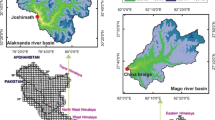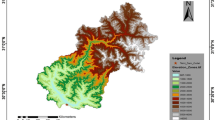Abstract
Snowmelt run-off model (SRM) based on degree-day approach has been employed to evaluate the change in snow-cover depletion and corresponding streamflow under different projected climatic scenarios for an eastern Himalayan catchment in India. Nuranang catchment located at Tawang district of Arunachal Pradesh with an area of 52 km2 is selected for the present study with an elevation range of 3143–4946 m above mean sea level. Satellite images from October to June of the selected hydrological year 2006–2007 were procured from National Remote Sensing Centre, Hyderabad. Snow cover mapping is done using NDSI method. Based on long term meteorological data, temperature and precipitation data of selected hydrological year are normalized to represent present climatic condition. The projected temperature and precipitation data are downloaded from NCAR’s GIS data portal for different emission scenarios (SRES), viz., A1B, A2, B1; and IPCC commitment (non-SRES) scenario for different future years (2020, 2030, 2040 and 2050). Projected temperature and precipitation data are obtained at desired location by spatially interpolating the gridded data and then by statistical downscaling using linear regression. Snow depletion curves for all projected scenarios are generated for the study area and compared with conventional depletion curve for present climatic condition. Changes in cumulative snowmelt depth for different future years are highest under A1B and lowest under IPCC commitment, whereas A2 and B1 values are in-between A1B and IPCC commitment. Percentage increase in streamflow for different future years follows almost the same trend as change in precipitation from present climate under all projected climatic scenarios. Hence, it was concluded that for small catchments having seasonal snow cover, the total streamflow under projected climatic scenarios in future years will be primarily governed by the change in precipitation and not by change in snowmelt depth. Advancing of depletion curves for different future years are highest under A1B and lowest under IPCC commitment. A2 and B1 values are in-between A1B and IPCC commitment.











Similar content being viewed by others
References
Abudu S, Cui C, Saydi M and King J P 2012 Application of snowmelt-runoff model (SRM) in mountainous watershed – A review; Water Sci. Engg. 5 (2) 123–136.
Bandyopadhyay A, Bhadra A, Maza M and Shelina R K 2014 Monthly variations of air temperature lapse rates in Arunachal Himalaya; J. Indian Water Resour. Soc. 34 (3) 16–25, ISSN: 0970-6984.
Bates B C, Kundzewicz Z W, Wu S and Palutikof J P (. 2008 Climate Change and Water; Technical Paper of the Intergovernmental Panel on Climate Change, IPCC Secretariat, Geneva, 210p.
Boudhar A, Hanich L, Boulet G, Duchemin B, Berjamy B and Chehbouni A 2009 Evaluation of the snowmelt runoff model in the Moroccan High Atlas Mountains using two snow-cover estimates; Hydrol. Sci. – Journal–des Sciences Hydrologiques 54 (6) 1094–1113.
Collins W D, Bitz C M, Blackmon M L, Bonan G B, Bretherton C S, Carton J A, Chang P, Doney S C, Hack J J, Henderson T B, Kiehl J T, Large W G, McKenna D S, Santer B D and Smith R D 2006 The Community Climate System Model Version 3 (CCSM3); J. Climate 19 2122–2143.
Dash S K, Jenamani R K, Kalsi S R and Panda S K 2007 Some evidence of climate change in twentieth-century India; Climate Change 85 299–321.
Gautam M R, Timilsina G R and Acharya K 2013 Climate Change in the Himalayas: Current State of Knowledge; Policy Research Working Paper 6516. The World Bank Development Research Group Environment and Energy Team.
Girod B, Wiek A, Mieg H and Hulme M 2009 The evolution of the IPCC’s emissions scenarios; Environ. Sci. Policy. doi: 10.1016/j.envsci.2008.12.006.
Hall D K, Riggs G A, Salomonson V V, diGirolamo N E and Bayr K J 2002 MODIS snow-cover products; Remote Sens. Environ. 83 181–194.
Hong M A and Guodong C 2003 A test of Snowmelt-Runoff Model (SRM) for the Gongnaisi river basin in the western Tianshan Mountains, China; Chinese Sci. Bull. 48 (20) 2253–2259.
Hughes D A, Hannart P and Watkins D 2003 Continuous baseflow separation from time series of daily and monthly streamflow data; Water SA 29 (1) 43–48.
Jain S K, Kumar V and Saharia M 2012 Analysis of rainfall and temperature trends in northeast India; Int. J. Climatol. doi: 10.1002/joc.3483.
Kulkarani A V, Singh S K, Mathur P and Mishra V D 2006 Algorithm to monitor snow cover using AWiFS data of RESOURCESAT-1 for the Himalayan Region; Int. J. Remote Sens. 27 (12) 2449–2457.
Kulkarni A V, Srinivasulu J, Manjul S S and Mathur P 2002 Field based spectral reflectance studies to develop NDSI method for snow cover monitoring; J. Indian Soc. Remote Sens. 30 (1&2) 73–80.
Ma Y, Huang Y, Chen X, Li Y and Bao A 2013 Modelling snowmelt runoff under climate change scenarios in an ungauged mountainous watershed, northwest China; Mathematical Problems in Engg. doi: 10.1155/2013/808565.
Martinec J, Rango A and Roberts R 2008 Snowmelt-Runoff Model (SRM); User’s Manual, WinSRM version 1.11 (eds) Gomez-Landesa E and Bleiweiss M P, New Mexico State University, Las Cruces, New Mexico, USA.
MOEF 2011 Project draft report on Arunachal Pradesh state action plan on climate change, 2011; Ministry of Environment and Forest (MOEF), Govt. of India, http://envfor.nic.in/downloads/public-information/Arunachal-Pradesh-SAPCC.pdf.
Nakicenovic N and Swart R (. 2000 Special report: Emissions scenarios; Intergovernmental Panel on Climate Change (IPCC), Cambridge University Press, UK.
Nakicenovic N, Grubler A, Gaffin S, Jung T T, Kram T, Morita T, Pitcher H, Riahi K, Schlesinger M, Shukla P R, Vuuren D V, Davis G, Michaelis L, Swart R and Victor N 2003 IPCC SRES revisited: A response; Energy & Environment 14 (2&3) 187–214.
PwC 2010 Third north east and east power summit: Profile and challenges – northeastern and eastern states of India; Energy and Utilities, Indian Chamber of Commerce (ICC), PricewaterhouseCoopers (PwC) Pvt. Ltd., India.
Rango A and Martinec J 1994 Areal extent of seasonal snow cover in a changed climate; Nordic Hydrology 25 (4) 233–246.
Senzeba K T, Bhadra A and Bandyopadhyay A 2015 Snowmelt runoff modelling in data scarce Nuranang catchment of eastern Himalayan region; Remote Sensing Applications: Society and Environment, pp. 20–35, ISSN: 2352-9385, doi: 10.1016/j.rsase.2015.06.001.
Solomon S, Qin D, Manning M, Chen Z, Marquis M, Averyt K B, Tignor M and Miller H L (. 2007 Climate change: The physical science basis; Contribution of working group I to the fourth assessment report of the Intergovernmental Panel on Climate Change (IPCC), Cambridge University Press, Cambridge, United Kingdom and New York, NY, USA.
Sorman A A, Gozel E and Sensoy A 2011 Snowmelt run-off prediction in the upper Euphrates basin, Turkey; In: Proc., 5th International Conference on Flood management (ICFM5) (27–29 September 2011), Tokyo, Japan.
Swain E, Stefanova L and Smith T 2014 Applying downscaled global climate model data to a hydrodynamic surface-water and groundwater model; Am. J. Clim. Change 3 33–49.
Welderufael W A and Woyessa Y E 2010 Streamflow analysis and comparison of base flow separion methods – Case study of the Modder river basin in central south Africa; European Water 31 3–12.
WMO 1964 Guide for Hydrometeorological Practices; World Meteorological Organisation (WMO), Geneva, Switzerland.
Author information
Authors and Affiliations
Corresponding author
Rights and permissions
About this article
Cite this article
SENZEBA, K.T., RAJKUMARI, S., BHADRA, A. et al. Response of streamflow to projected climate change scenarios in an eastern Himalayan catchment of India. J Earth Syst Sci 125, 443–457 (2016). https://doi.org/10.1007/s12040-016-0680-3
Received:
Revised:
Accepted:
Published:
Issue Date:
DOI: https://doi.org/10.1007/s12040-016-0680-3




